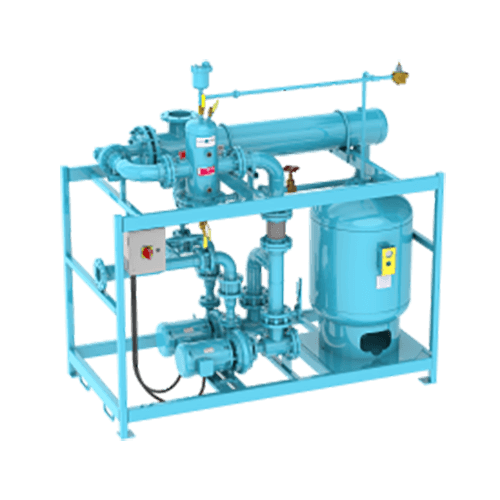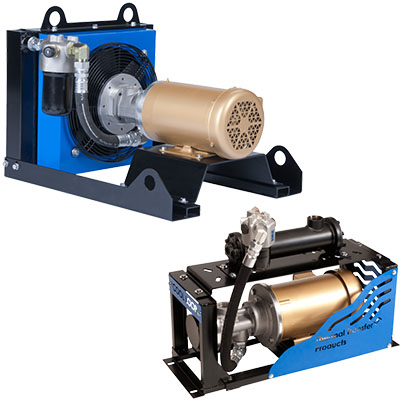How DVS Heat Transfer Systems Utilize Advanced Materials to Boost Thermal Conductivity
Technologies in Heat Transfer Equipments: What You Need to Know for Ideal Efficiency
Advancements in Heat transfer systems are changing efficiency across different sectors. Advanced products like graphene and nanofluids guarantee substantial improvements in thermal conductivity. At the same time, the integration of IoT and maker discovering offers opportunities for real-time surveillance and improved power performance. Nevertheless, the landscape of thermal monitoring is quickly evolving (DVS Heat Transfer Systems). Recognizing these developments is essential for attaining excellent system performance and sustainability in the future. What details improvements are forming this change?
Arising Products for Improved Heat Transfer

Advanced Heat Exchanger Designs
While typical Heat exchangers have actually served their purpose in various applications, progressed designs are currently arising to fulfill the raising demands for efficiency and performance. These ingenious designs, such as plate, shell-and-tube, and finned-tube Heat exchangers, include enhanced area and boosted circulation patterns to raise thermal transfer prices. On top of that, compact designs permit lowered space requirements without endangering efficiency. Advanced materials, such as composites and corrosion-resistant alloys, in addition enhance longevity and performance under extreme problems. Additionally, simulation innovations and computational liquid characteristics are progressively employed to fine-tune these styles, making sure peak Heat transfer features. As markets seek to lessen energy usage and make the most of output, the adoption of innovative Heat exchanger designs is essential in accomplishing these objectives.
The Duty of Nanotechnology in Heat Transfer
Nanotechnology plays a vital duty in improving thermal conductivity within Heat transfer systems. By controling products at the nanoscale, researchers have actually achieved substantial improvements in power effectiveness. These advancements not only optimize performance yet also add to even more lasting power solutions.
Enhanced Thermal Conductivity
Considerable developments in thermal conductivity have actually arised through the application of nanotechnology, changing Heat transfer systems across different sectors. By integrating nanoparticles right into Heat transfer liquids and products, researchers have achieved amazing boosts in thermal conductivity. These nanoparticles, such as carbon nanotubes, graphene, and metal oxides, enhance the Heat transfer properties due to their high surface and one-of-a-kind thermal qualities. The resulting composites display boosted efficiency in applications ranging from electronic devices cooling systems to renewable resource innovations. In addition, the ability to tailor the size, form, and make-up of nanoparticles permits maximized thermal administration services. Therefore, nanotechnology remains to play a pivotal function in the advancement of extra effective and reliable Heat transfer systems, leading the way for boosted industrial applications.
Power Performance Improvements

Combination of IoT in Heat Transfer Systems
The integration of IoT in Heat transfer systems introduces the application of wise sensing units that enhance functional effectiveness. These sensors enable real-time information monitoring, allowing for prompt changes and optimizations. This technological innovation has the prospective to considerably enhance performance and power administration in Heat transfer applications.
Smart Sensors Application
As Heat transfer systems develop, the assimilation of smart sensing units with the Web of Things (IoT) has become a transformative approach. These sensors enable real-time tracking of stress, circulation, and temperature level rates, improving system effectiveness and reliability. By collecting and sending data, they help with aggressive maintenance, lowering the risk of system failures. Furthermore, smart sensing units contribute to energy cost savings by refining functional parameters based upon environmental conditions. Their capability to analyze patterns and abnormalities allows for notified decision-making, guaranteeing peak efficiency of Heat transfer systems. As markets increasingly embrace this modern technology, the execution of clever my review here sensors stands to revolutionize exactly how Heat transfer systems are taken care of, paving the way for better sustainability and boosted efficiency end results.
Real-Time Information Surveillance
Exactly how can real-time data monitoring improve the efficiency of Heat transfer systems? By integrating Web of Things (IoT) technology, Heat transfer systems can utilize constant information collection from wise sensors. This real-time surveillance permits prompt evaluation of temperature level, pressure, and circulation prices, making it possible for drivers to recognize inadequacies promptly. As a result, changes can be made to optimize efficiency, decrease power usage, and expand devices life expectancy. Furthermore, predictive maintenance can be carried out, minimizing unforeseen downtime and costly fixings. The capacity to picture performance metrics via dashboards enhances decision-making, promoting an aggressive approach to system administration. Inevitably, real-time information checking not just boosts functional effectiveness however additionally adds to sustainability goals within industrial procedures.
Energy Performance and Sustainability Trends
Power performance and sustainability fads are reshaping the landscape of Heat transfer systems, driving technology and compliance throughout different industries. Organizations are progressively prioritizing energy-efficient styles to minimize functional prices and reduce ecological impacts. The combination of renewable resource resources is ending up being a lot more common, allowing Heat transfer systems to run sustainably while fulfilling regulative demands. Furthermore, innovations in modern technologies and products advertise reduced power consumption and boost total efficiency. Lifecycle analyses are likewise gaining grip, enabling companies to assess the ecological effect of Heat transfer systems from production to disposal. This concentrate on sustainability not just sustains company duty yet also placements companies competitively in a market where customers increasingly prefer environment-friendly solutions. Power performance and sustainability stay essential factors to consider for future developments in Heat transfer technology.
Advancements in Thermal Monitoring Solutions
While the demand for efficient Heat transfer proceeds to increase, innovations in thermal administration solutions are emerging to deal with both efficiency browse around these guys and sustainability obstacles. Advanced materials, such as stage modification materials and nanofluids, are being created to boost Heat transfer performance - DVS Heat Transfer Systems. These materials boost thermal conductivity and permit far better temperature policy in numerous applications. Furthermore, technologies like active thermal control systems are getting traction, making it possible for real-time modifications to take care of Heat flow effectively. These systems add to power financial savings and decrease the ecological influence of thermal procedures. In addition, the combination of IoT in thermal management assists in tracking and predictive upkeep, guaranteeing maximized performance and durability of Heat transfer systems. On the whole, these technologies stand for considerable strides towards more sustainable thermal management techniques
Future Instructions in Heat Transfer Innovation
Arising improvements in thermal management remedies indicate an encouraging future for Heat transfer technology. Researchers are progressively concentrating on establishing products with superior thermal conductivity and enhanced energy performance. Innovations such as nanofluids, which consist of put on hold nanoparticles, provide considerable renovations in Heat transfer performance. Additionally, the combination of clever products that adjust to differing temperature level conditions is obtaining traction, permitting more responsive and reliable systems. The rise of additive manufacturing strategies is additionally enabling the layout of intricate Heat exchanger geometries that enhance liquid flow. The application of machine discovering algorithms is prepared for to transform the optimization of Heat transfer systems, assisting in anticipating upkeep and performance improvement. Jointly, these innovations are poised to change the landscape of Heat transfer innovations in various sectors.

Regularly Asked Inquiries

How Do I Select the Right Heat Transfer System for My Application?
Selecting the appropriate Heat transfer system entails examining application needs, including temperature level varieties, fluid properties, and efficiency needs. Assessing system types, maintenance factors to consider, and cost-effectiveness additionally plays a necessary duty in making an educated choice.
What Are the Maintenance Needs for Advanced Heat Exchangers?
Maintenance requirements for innovative Heat exchangers commonly consist of routine evaluations, checking for leaks, cleansing of surface areas, and assuring perfect circulation prices. Following maker guidelines assurances effective operation and prolongs the equipment's life expectancy.
Just How Do Environmental Elements Affect Heat Transfer Performance?
Ecological elements considerably influence Heat transfer performance. Variants in airflow, temperature, and humidity impact thermal conductivity and convective Heat transfer, ultimately influencing system efficiency and necessitating factor to consider during the layout and operation of Heat transfer systems.
What Safety And Security Requirements Relate To Heat Transfer Equipments?
Safety criteria for Heat transfer systems usually consist of guidelines from organizations such as ASME and ASTM. DVS Heat Transfer Systems. These standards address products, design, and functional techniques to guarantee reliability, effectiveness, and defense versus dangers in various applications
Just How Can I Fix Usual Heat Transfer System Issues?
Repairing typical Heat transfer system problems includes looking for leaks, making certain correct fluid circulation, examining insulation stability, and validating temperature differentials. Identifying these elements can assist keep system efficiency and protect against further difficulties.
Nanotechnology plays a necessary function in improving thermal conductivity within Heat transfer systems. Substantial innovations in thermal conductivity have actually emerged with the application of nanotechnology, reinventing Heat transfer systems across various markets. Innovations in thermal conductivity via nanotechnology have led the means for remarkable improvements in energy efficiency within Heat transfer systems. Power performance and sustainability patterns are reshaping the landscape of Heat transfer systems, driving technology and conformity across various markets. The integration of IoT in thermal monitoring assists in monitoring and anticipating upkeep, look at here now making certain optimized efficiency and longevity of Heat transfer systems.